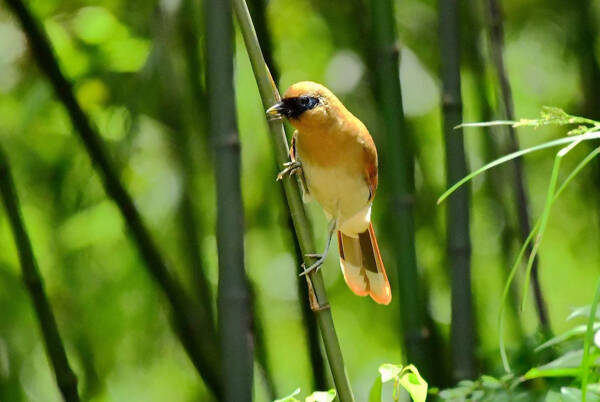Pterorhinus berthemyi
IUCN
LCBasic Information
Scientific classification
- name:Pterorhinus berthemyi
- Scientific Name:Pterorhinus berthemyi,Rusty Laughingthrush,Bamboo bird, Eight-tone bird
- Outline:Songbird
- Family:Passeriformes Thrushidae Laughingthrush
Vital signs
- length:23-29cm
- Weight:80-100g
- lifetime:About 10 years
Feature
Fear of life, dislike open areas
Distribution and Habitat
Origin: China.
In China, it is mainly distributed in Sichuan, Guizhou, Yunnan, Anhui, Zhejiang, Fujian and Taiwan.
It mainly lives in mountain evergreen broad-leaved forests at an altitude of 1,000 to 2,700 meters, especially in rocky areas with well-developed understory plants, dark, moist and covered with moss.
Appearance
The male and female feathers are similar in color. The upper body is ocher brown, the nose feathers, forehead, eye first, eye periphery, upper ear feathers, front cheek and chin are black. There is a narrow light black feather edge from the top of the head to the back of the neck, forming scaly spots on the top of the head. The inner coverts and flight feathers of the two wings are the same color as the back, the outer coverts are brown, the outer coverts of the flight feathers are brown, and the inner cover is dark brown. The central pair of tail feathers are brown maroon, the outer feathers are brown chestnut, and the inner feathers are dark brown. The outer tail feathers are brown and chestnut gradually become lighter from the inside to the outside. The outer feathers of the outermost tail feathers also turn into dark brown, and the outermost three pairs of tail feathers are brown. The tail feathers have broad white terminal spots. The throat and upper chest are light ocher brown, t
Details
The foreign name of the brown babbler is Rusty Laughingthrush, and there are three subspecies. Dickinson (2003) divided the brown babbler (G.poecilorhynchus) into three subspecies. Some scholars believe that the named subspecies of Brown Noisy Babbler (G.p. poecilorhynchus) is significantly different from the other two subspecies and can be regarded as different species (Collar 2006, Collar & Robson 2007).

The genus name of the brown babbler, Garrulax, is Latin for "chattering", and the species name po-ecilorhynchus is a combination of the Greek words poikilos and rhunkhos, the former meaning "spot" and the latter meaning "beak".
Brown Noisy Babblers like to live in small groups in the understory vegetation and bamboo forest layers of virgin broad-leaved forests in hills and mountains. Fear of life and dislike open areas. Often alone or in small groups. It is shy and good at hiding. It is mostly active on the ground among the bushes in the forest. It rarely goes to the middle and upper levels of the forest, so it is not easy to see. However, this bird is good at singing and likes to flock, so it appears to be noisy. Its sound is often heard but its shadow is difficult to find. If one member of the group is killed, the rest will scramble to avoid it. During the breeding period, the song is also very euphemistic and pleasant. The sound is like "Hu~Guo~Hu, Huhu". It is a whistle that is repeated repeatedly. The sound is mellow and full of changes.
Brown Noisy Babblers will build their nests on the branches of low trees in early May. The nests are about 2 meters high from the ground. They use dry leaves, grass stems and grass roots as nest materials, and are lined with some white linear plants of usnea. Inside. The nest is bowl-shaped, 136 mm high, 50 mm deep, 140 mm outer diameter, and 102 mm inner diameter. A clutch lays 2 to 3 eggs, which are blue in color without any spots. The size of the eggs is 3 3 x 22 mm. The chicks are fed in turn by their parent birds.
The global population of Brown Noisy Babbler has not been quantified, and it is a rare to relatively common bird species in its native area (del Hoyo et al. 2007). The brown babbler is a specialty bird in China. It is abundant in Zunyi, Suixian, Jiangkou, Huishui and Leishan areas of Guizhou. Many of these birds are also found in the Huangshan scenic area of Anhui. They are rare and not common in other areas and should be protected.
Listed in The IUCN Red List: Least Concern (LC), 2015 assessment.
Included in the "List of Terrestrial Wild Animals Protected by the State that Are Beneficial or of Important Economic and Scientific Research Value" issued by the State Forestry Administration of China on August 1, 2000. (Note: Item 491 Brown Noisy Babbler).
It is included in the list of national second-level protected animals.
Protect wild animals and eliminate wild game.
Maintaining ecological balance is everyone’s responsibility!








